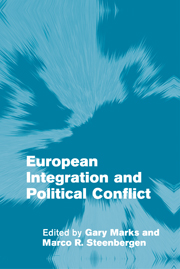Book contents
- Frontmatter
- Contents
- List of figures
- List of tables
- List of contributors
- Preface
- Introduction: Models of political conflict in the European Union
- Part I Citizens
- Part II Political parties
- 5 Defining the EU political space: an empirical study of the European election manifestos, 1979–1999
- 6 Does left/right structure party positions on European integration?
- 7 Political competition in the European Parliament: evidence from roll call and survey analyses
- 8 Contesting Europe? The salience of European integration as a party issue
- Part III Groups
- References
- Index
6 - Does left/right structure party positions on European integration?
Published online by Cambridge University Press: 22 September 2009
- Frontmatter
- Contents
- List of figures
- List of tables
- List of contributors
- Preface
- Introduction: Models of political conflict in the European Union
- Part I Citizens
- Part II Political parties
- 5 Defining the EU political space: an empirical study of the European election manifestos, 1979–1999
- 6 Does left/right structure party positions on European integration?
- 7 Political competition in the European Parliament: evidence from roll call and survey analyses
- 8 Contesting Europe? The salience of European integration as a party issue
- Part III Groups
- References
- Index
Summary
How is contestation on European integration structured among political parties competing in the member states? How is it related, if at all, to the political conflicts that have shaped political life in Western Europe?
The framework within which we pose these questions is the standard model of European party system dynamics consisting of the following elements:
Contestation among political parties is limited to one or two dimensions. This renders competition among parties institutionally and intellectually tractable.
These dimensions are, first, a left/right dimension tapping greater vs. lesser government regulation of market outcomes and, in many party systems, a related new politics dimension tapping communal, environmental, and cultural issues.
The general question we ask in this chapter is whether issues arising from European integration are assimilated into these existing dimensions of domestic contestation. Can the positions that political parties take on European issues be read from their positions on the left/right and new politics dimensions? Or are these European issues unrelated – orthogonal – to these dimensions? Does European integration put a new and potentially disruptive set of issues on the agenda that cannot be swallowed within existing patterns of political contestation? If these issues are assimilated, how are they assimilated? What, in other words, are the substantive connections between party positioning on European integration and party positioning on the dimensions that structure domestic politics?
One must, we believe, disaggregate European integration into its particular policies (e.g., environmental, cohesion, and fiscal policy) in order to answer these questions accurately.
- Type
- Chapter
- Information
- European Integration and Political Conflict , pp. 120 - 140Publisher: Cambridge University PressPrint publication year: 2004
- 77
- Cited by



